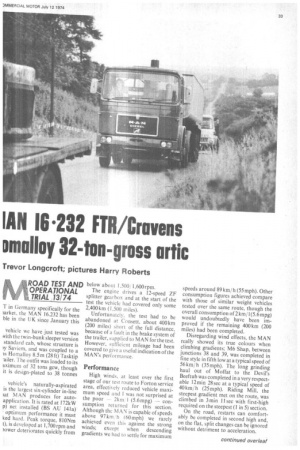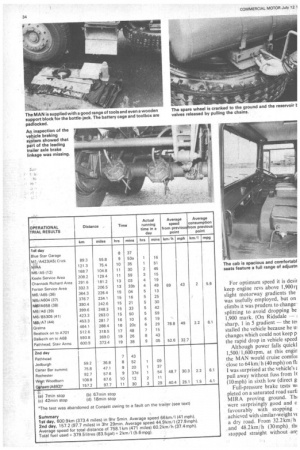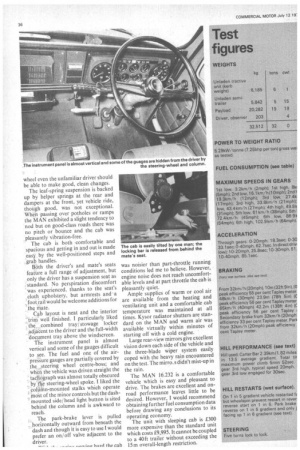IAN 16 •232 FTR/Cravens mmalloy 32-ton-gross artic
Page 35

Page 36

Page 37

Page 38

If you've noticed an error in this article please click here to report it so we can fix it.
Trevor Longcroft; pictures Harry Roberts
T in Germany specifically for the tarket, the MAN 16.232 has been ble in the UK since January this vehicle we have just tested was with the twin-bunk sleeper version standard cab, whose structure is Saviem, and was coupled to a Homalloy 8.5 m (28 ft) Tasktip -alter. The outfit was loaded to its aximum of 32 tons gcw, though it is design-plated to 38 tonnes vehicle's naturally-aspirated is the largest six-cylinder in-line iat MAN produces for autoapplication. It is rated at 172kW p) net installed (BS AU 141a) • optimum performance it must ked hard. Peak torque, 810Nm t), is developed at 1,700 rpm and iower deteriorates quickly from below about 1,500/ 1,600 rpm.
The engine drives a 12-speed ZF splitter gearbox and at the start of the test the vehicle had covered only some 2,400 km (1,500 miles).
Unfortunately, the test had to be abandoned at Consett, about 400 km (200 miles) short of the full distance, because of a fault in the brake system of the trailer, supplied to MAN for the test. However, sufficient mileage had been covered to give a useful indication of the MAN's performance.
Performance
High winds, at least over the first stage of our test route to Forton service area, effectively reduced vehicle maximum speed and I was not surprised at the poor — 2km:1 (5.6 mpg) — consumption returned for this section. Although the MAN is capable of speeds above 97km: h (60mph) we rarely achieved even this against the strong winds; except when descending gradients we had to settle for maximum speeds around 89km/ h (55 mph). Other consumption figures achieved compare with those of similar weight vehicles tested over the same route, though the overall consumption of 2 km/1(5.6 mpg) would undoubtedly have been improved if the remaining 400 km (200 miles) had been completed.
Disregarding wind effects, the MAN really showed its true colours when climbing gradients; M6 Shap, between junctions 38 and 39, was completed in fine style in fifth low at a typical speed of 56km/ h (35mph). The long grinding haul out of Moffat to the Devil's Beeftub was completed in a very respectable 12min 28 sec at a typical speed of 40 km/ h (25mph). Riding Mill, the steepest gradient met on the route, was climbed in 3min 11 sec with first:high required on the steepest (1 in 5) section.
On the road, restarts can comfortably be Completed in second high and, on the flat, split changes can be ignored without detriment to acceleration. For optimum speed it is desit keep engine revs above 1,90011 slight motorway gradients the was usefully employed, but on climbs it was prudent to change • splitting to avoid dropping be 1,900 mark. (On Ridsdale ; sharp, I in 5 gradient the te!. stalled the vehicle because he u! changes which could not keep p the rapid drop in vehicle speed Although power falls quickl 1,500/ 1,600 rpm, at this engir the MAN would cruise comfoi close to 64 km/ h (40 mph) on ft I was surprised at the vehicle's I pull away without fuss from l) (10 mph) in sixth low (direct g Full-pressure brake tests wi pleted on a saturated road surf4 MIRA proving ground. Thi Were surprisingly good and c favourably with stopping achieved with similar-weight vt a dry road. From 32.2 kmi h and 48.2 km/h (30mph) th( stopped straight without an tability. But from 64.4 km/ h mph) the unit 'veered to the near -he braking results are all the more )nishing because later investigation .:aled that the brakes on the leadingler axle were not connected. After very hilly A68 section of our route nearside rear linings on the tractive began to overheat. Engaging the ler park brakes in order to check the on of the tractive unit spring brakes liscovered that the diaphragm pushends on the leading trailer axle were connected to the `S' cam-actuating rs. The jaws and clevis pins were ing and close inspection made it 3tful whether they had ever been J. We parked the outfit in a layby, rely braked, and contacted Cravens talloy for assistance. This was used, but the service vehicle appar • broke down on its•way to us and a long wait we had to abandon the is to the credit of the MAN's brake m that no hint of braking iency had been noticed earlier. At imes the brakes had responded ctly and, if anything, the brakes better than those of other 32-ton s I have drivenl as doubtful about the efficiency of irk brake, which only just held the e when facing up a 1 in 6 gradient gal requirement) at MIRA. Howlater in the test, the brake easily he vehicle on the I in 5/6 Ridsdale
and handling
the Saviem (CM April 26), the features a steering column gearwhich I found as easy to use as a :hange arrangement. The neutral )incides with the steering column dd gears arc forward and even arward. The lever is biased to the te position between third and and after a short period at the wheel even the unfamiliar driver should be able to make good, clean changes.
The leaf-spring suspension is backed up by helper springs at the rear and dampers at the front, yet vehicle ride, though good, was not exceptional. When passing over potholes or ramps the MAN exhibited a slight tendency to nod but on good-class roads there was no pitch or bounce and the cab was pleasantly vibration-free.
The cab is both comfortable and spacious and getting in and out is made easi, by the well-positioned steps and ;grab handles. I:14th the driver's and mate's seats feai-bre a full range of adjustment, but only the driver has a suspension seat as : standard. No perspiration discomfort was experienced, thanks to the seat's ,cloth upholstery, but armrests and 'a foot rail would be welcome additions for -1 • the mate.
Cab layout is neat and the interior trim well finished. I particularly liked , the. combined tray/ stowage locker adjacent to the driver and the full-width document tray above the windscreen. • The instrument panel is almost vertical and some of the gauges difficult to re. The fuel and one of the airpressure gauges are partially covered by the „steering wheel centre-boss; and when the vehicle was driven straight the tactiograph was almost totally obscured • by'g-tif steering-wheel spoke. I liked the " column-mounted stalks which operate !I • mo-st of the minor controls but the dashmounted side/head light button is sited behind the column and is awkward to reach.
The park-brake lever is pulled • horizontally outward from beneath the dash and though it is easy to use I would prefer an on/ off valve adjacent to the driver. , .-.,zn,;na hard the cab was noisier than part-throttle running conditions led me to believe. However, engine noise does not reach uncomfortable levels and at part throttle the cab is pleasantly quiet.
Ample supplies of warm or cool air are available from the heating and ventilating unit and a comfortable cab temperature was maintained at all times. Kysor radiator shutters are standard on the MAN and warm air was available virtually within minutes of starting off with a cold engine.
Large rear-view mirrors give excellent vision down each side of the vehicle and the three-blade wiper system easily coped with the heavy rain encountered on the test. The mirro. s didn't mist-up in the rain.
The MAN 16.232 is a comfortable vehicle which is easy and pleasant to drive. The brakes are excellent and onroad performance leaves little to be desired. However, I would recommend obtaining further fuel consumption data before drawing any conclusions to its operating economy.
The unit with sleeping cab is £300 more expensive than the standard unit which costs £9,995. It cannot be coupled to a 40 ft trailer without exceeding the 15m overall-length restriction.




























































































